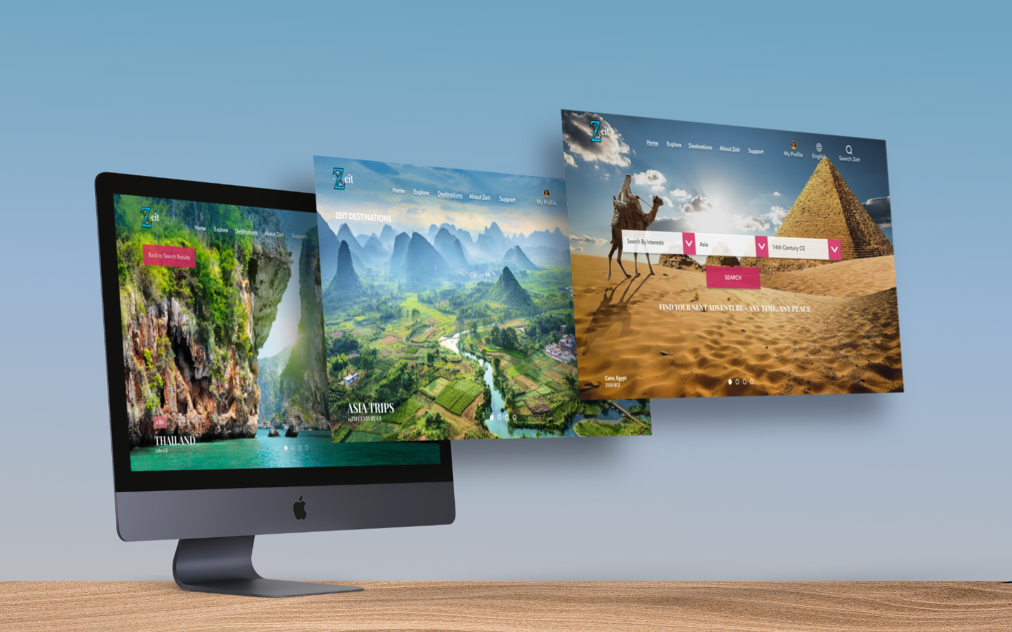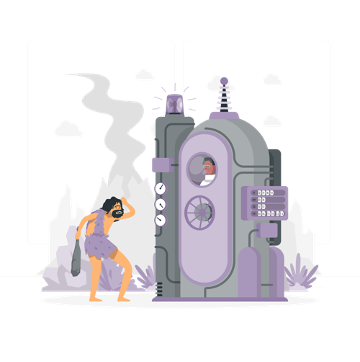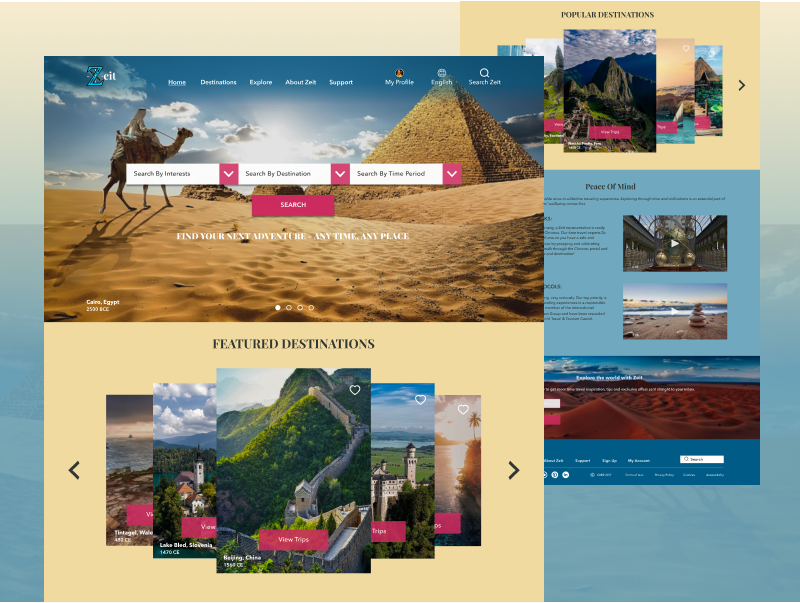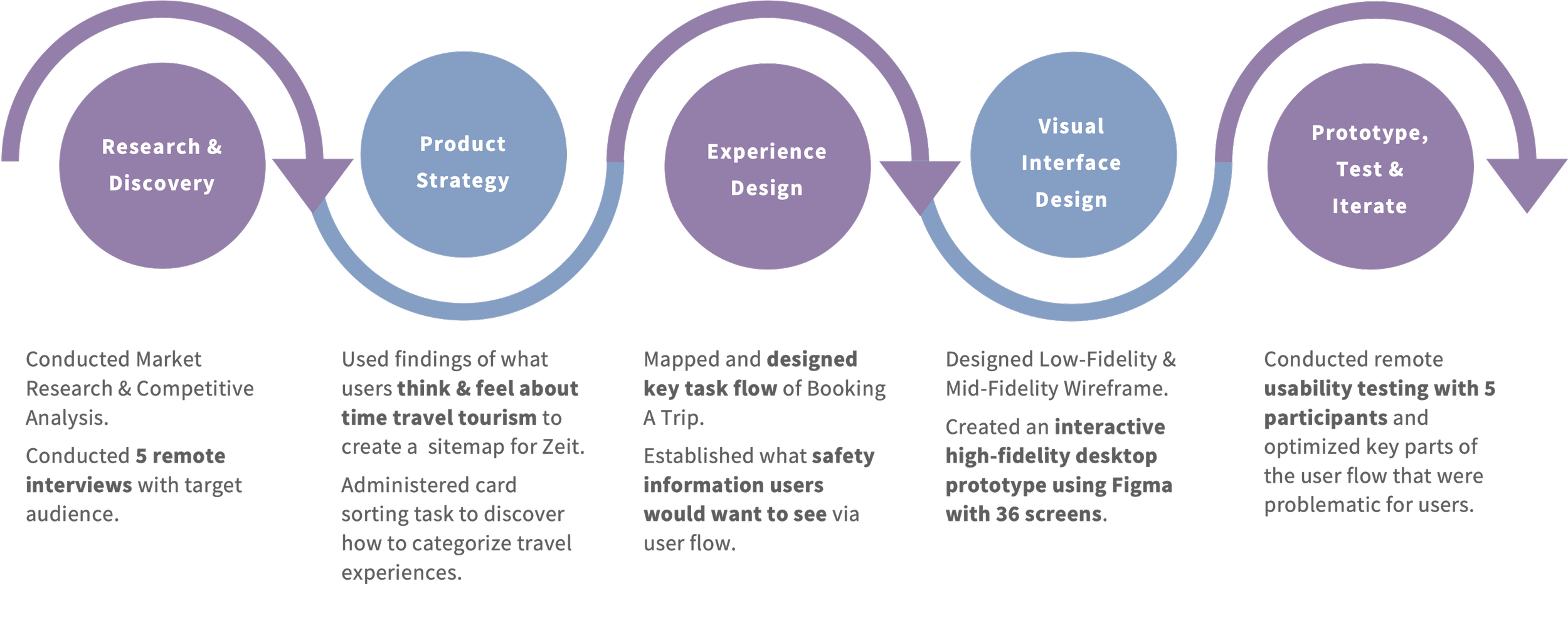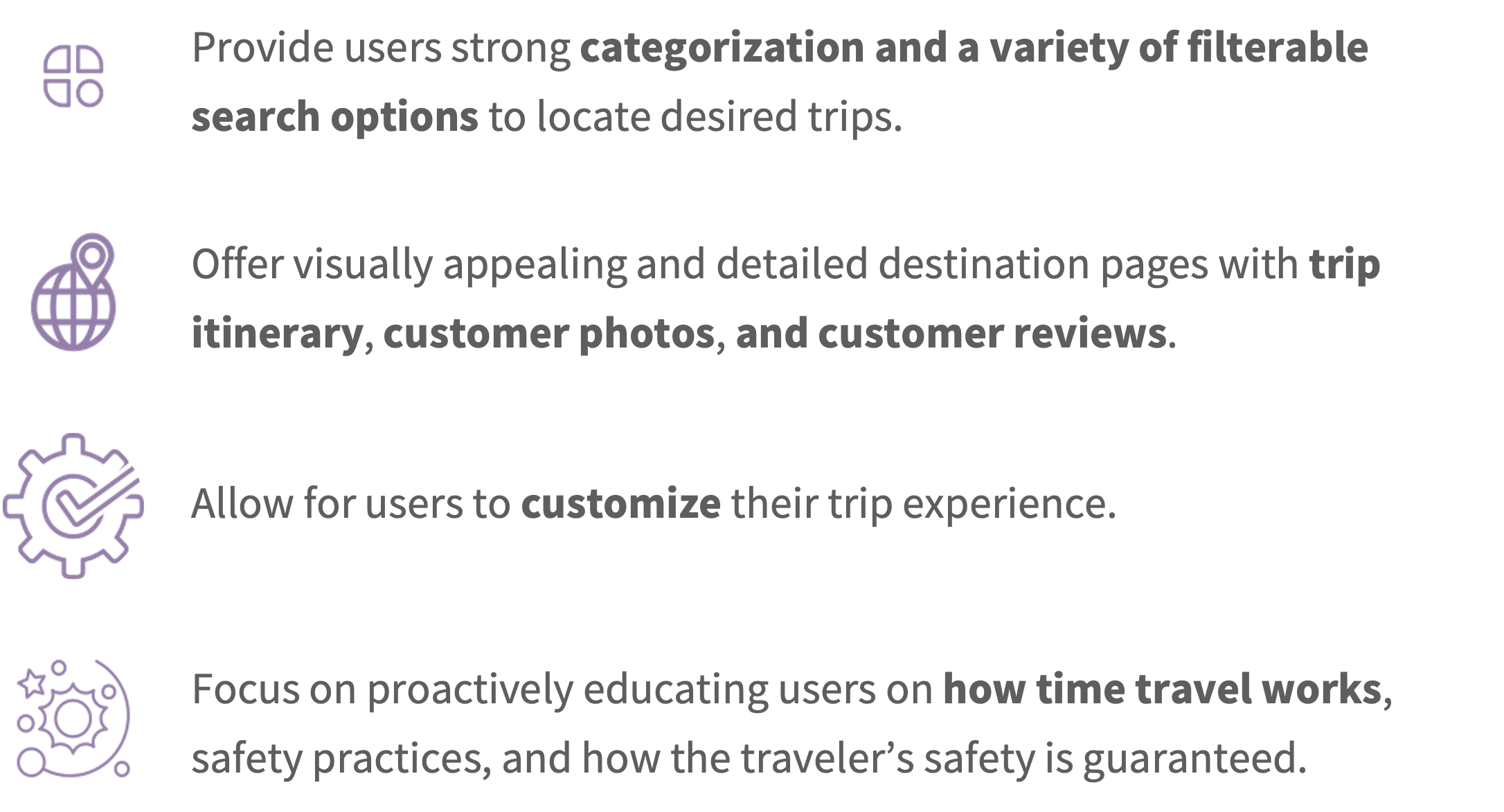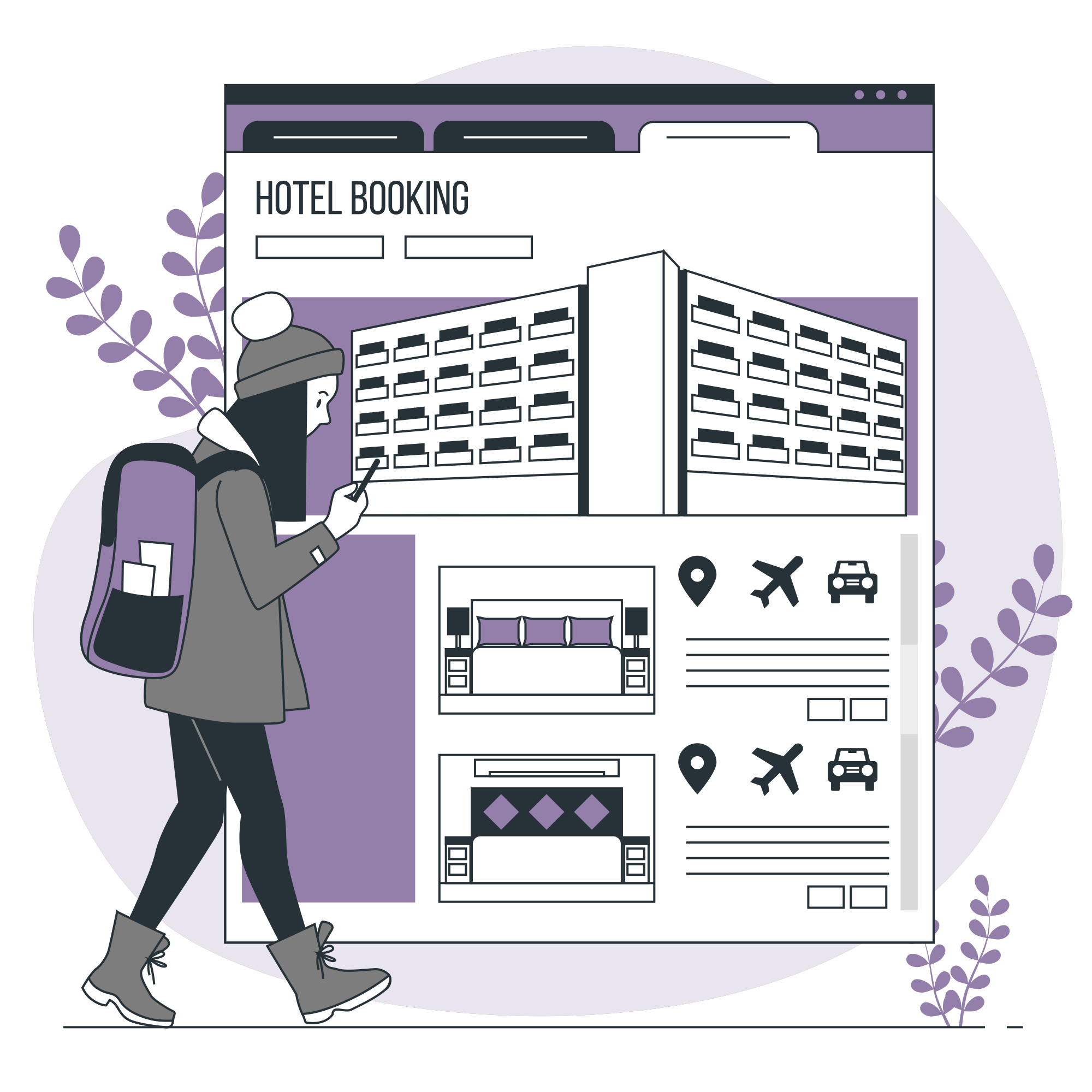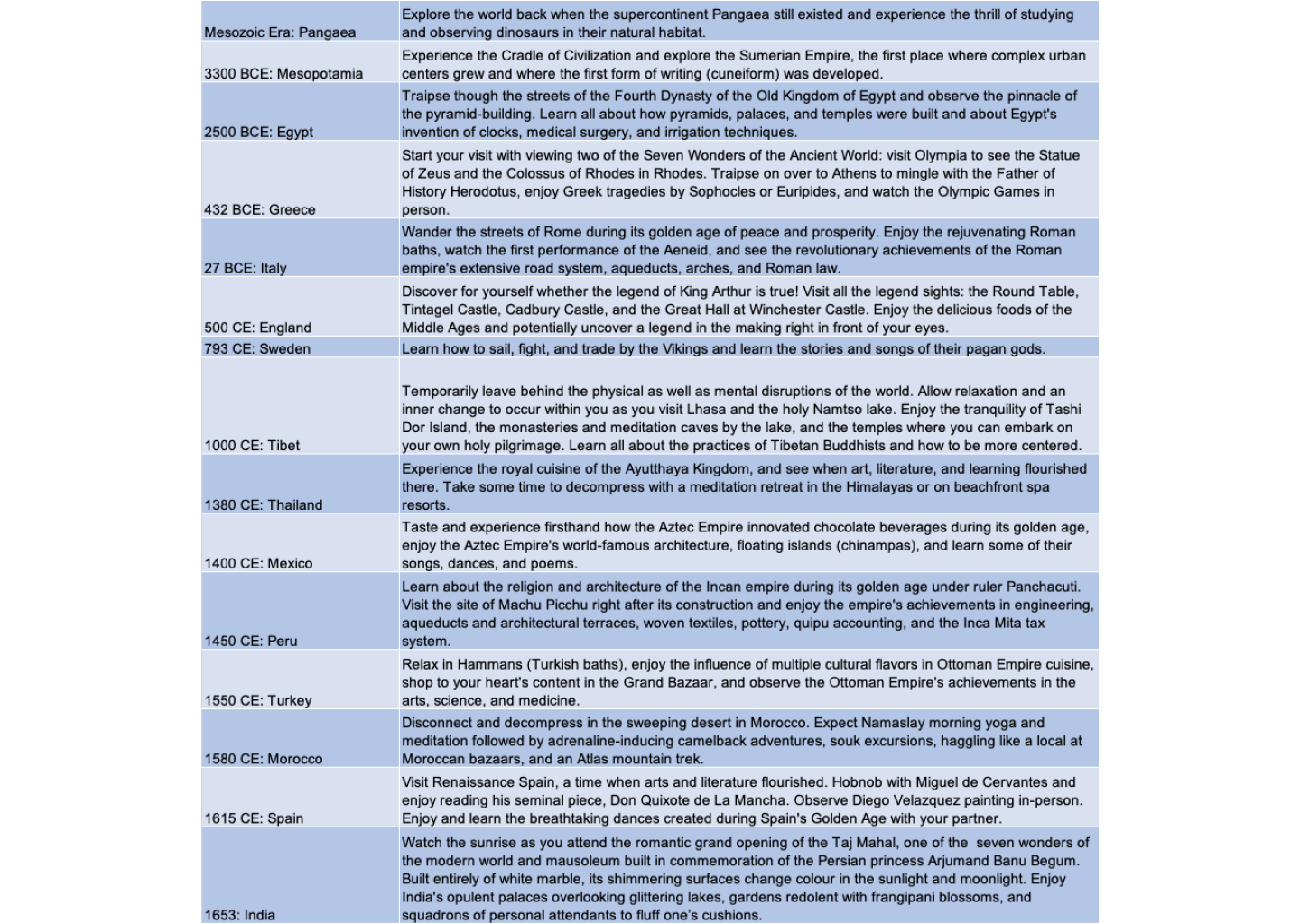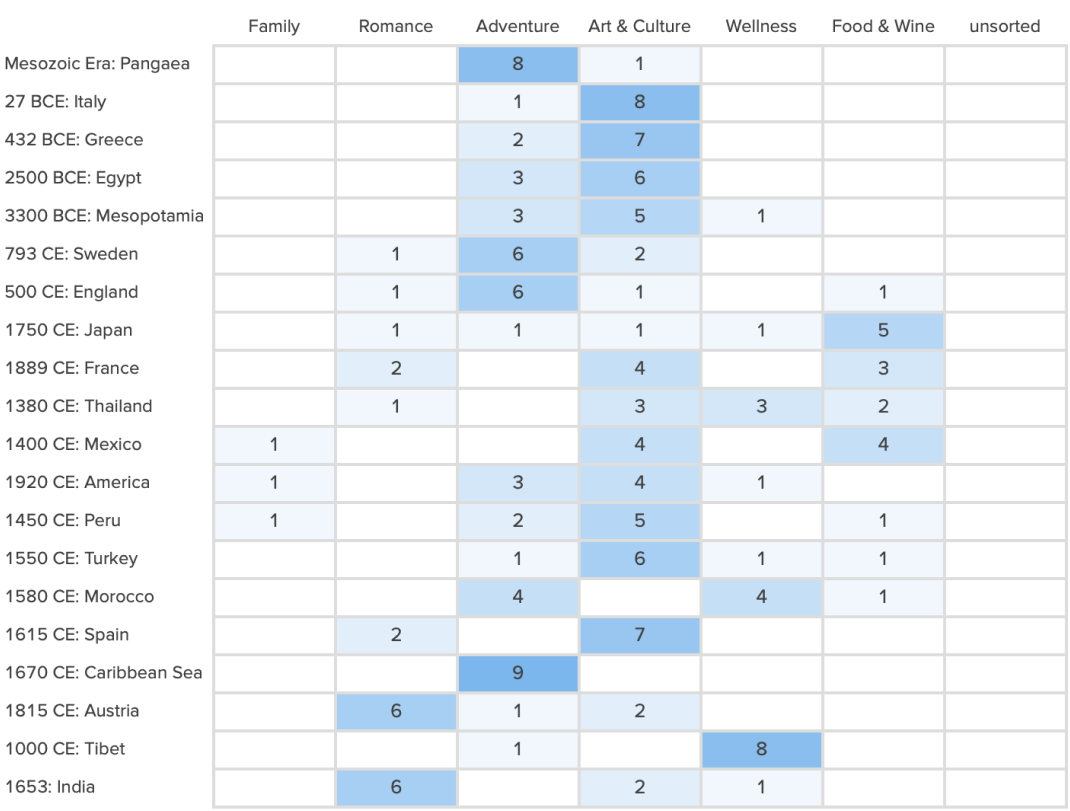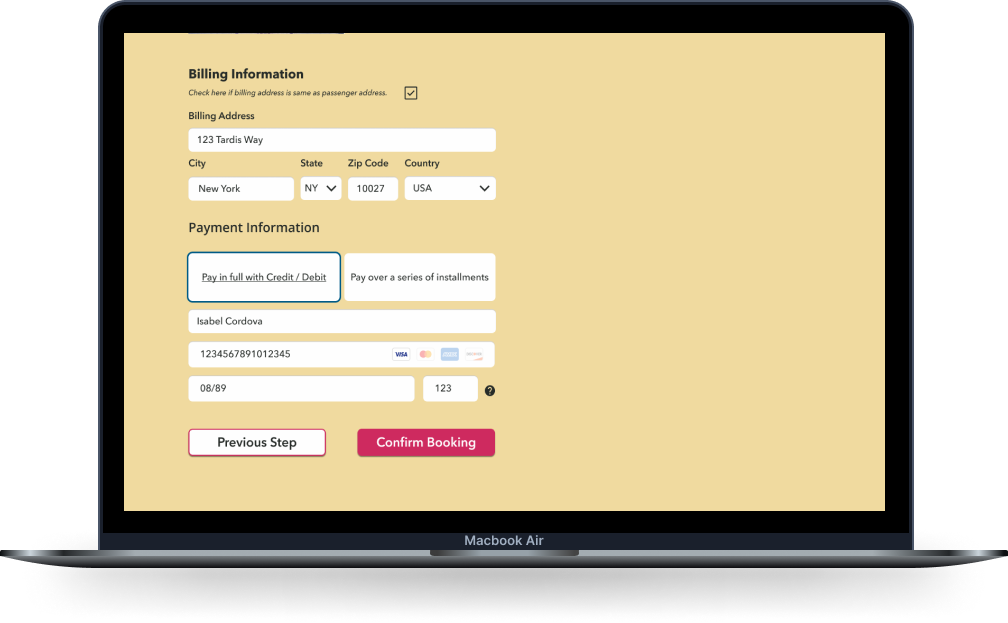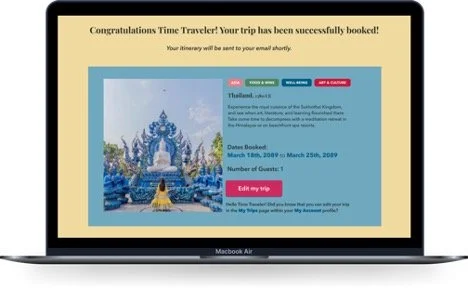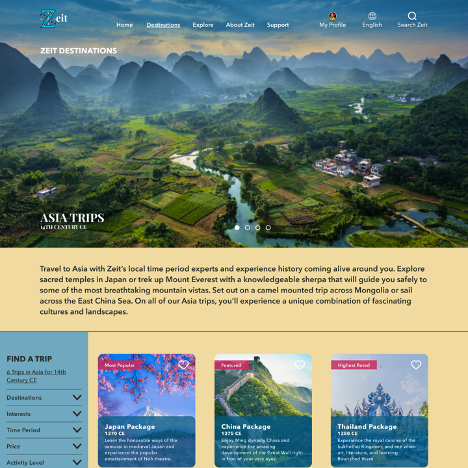WHAT WAS THE PROJECT?
Responsive e-commerce website for a conceptual groundbreaking technology travel company
Client: Zeit Time Travel Tourism
Project Summary
Democratize an emerging travel technology and luxury brand without sacrificing wonder, service, and style. Empower informed and savvy shopping.
Rich, scrollable pages. Add contextual tags for easy searching, informed browsing and easy booking.
The Strategy
Results. 81% usability score and 100% satisfaction with content design.
Why You Should Care
Qualitative Research
Experience Design
Interface Design
Usability Testing
Content Design
Responsibilities
MY ROLE IN THE CREATION OF ZEIT
User Research
Conducted a mixed-methods research approach that included market research, primary research, and card sorting with stakeholders.
Experience Design
Designed information architecture, created product branding, and conducted usability testing.
Content Design
Developed wondrous and adventurous brand voice.
WHAT PROBLEM IS ZEIT TRYING TO SOLVE?
Public opinion and interest in exploratory technologies like time travel is unknown.
Women prioritize personal safety when making travel accommodations:
63% of women think about safety frequently or always while traveling.
Many individuals are hesitant to try new technologies:
Historically, there has been resistance to new technologies because of public perception that the benefits of the new technology will only accrue to a small section of society.
Travelers of color are concerned about discrimination and racism:
Racial profiling is prevalent
Uncomfortable staring is common
Foreigners tend to ask blunt questions
PROJECT STRATEGY
Proposed Solution to the Problem:
Zeit has boldly made time travel tourism available to the public. Offering a total of 289 destinations all over the world throughout time, users can safely and securely book trips to destinations in the time period of their choosing.
Zeit provides its travelers with:
Unique, curated activities and experiences based on user interests for that era and destination.
Informational transparency on pricing and how time travel technology works.
Customizable trip experiences.
PROJECT SUMMARY
Zeit is a responsive e-commerce site for a conceptual groundbreaking technology travel company... and it is a hit!
81%
Average Usability Score
100%
Satisfaction with Content Design
86%
Average Design Score
DESIGN PROCESS
I conducted this independent 8-week passion project from strategy to prototype.
RESEARCH & DISCOVERY
Price, informational transparency, and user reviews are most important factors to travelers when booking trips.
Robust filter and search functionality will help users find the right trip for them.
Strong variety of locations, accommodations, and activities are pivotal to success for an e-commerce travel business.
Plans for travel will be led by millennials and gen-z, and they prioritize flexibility, affordability, and independence.
Key insights gained from industry research and competitive analysis on Zeit’s indirect competitors include the following:
“I want to be able to plan out and customize my trip itinerary to my interests and budget.”
RESEARCH & DISCOVERY
I planned and conducted 5 remote interviews with participants to determine how users think when it comes to planning, researching, and booking travel experiences and to learn more about their thoughts and concerns regarding the concept of time travel. Participants were recruited to match Zeit’s target audience.
Cost, booking flexibility, user photos/reviews, and safety were the most important travel considerations
Budget-friendly group packages
USER NEEDS
Most listed reasons for not using some travel booking websites were poor accessibility design, hidden fees, and misinformation
Planning trips is a hassle
USER FRUSTRATIONS
RESEARCH & DISCOVERY
Interview participants of color had concerns about the safety of time travel tourism.
Only white male participant (n = 1) expressed interest in time traveling.
Rest of participants (n = 4; all belonged to historically marginalized and oppressed groups) expressed fear over the concept of time travel due to history of discrimination and oppression to people that looked like them.
Time Travel Insights
What They Said
“I love to travel and learn about different cultures, but I would be too concerned about creating a time paradox or about experiencing racism from locals to ever consider time travel.”
RESEARCH & DISCOVERY
Based on the research, I focused on two primary Zeit users:
A millennial cultured frequent traveler
A gen-z thrill-seeking casual traveler
RESEARCH & DISCOVERY
Based on the research, I focused on two primary Zeit users:
A millennial cultured frequent traveler
A gen-z thrill-seeking casual traveler
PRODUCT STRATEGY
The market research, research on the acceptance of emerging technologies, and individual interviews revealed design opportunities for Zeit.
“I want to be able to plan out and customize my trip itinerary to my interests and budget.”
PRODUCT STRATEGY
I created a sitemap to help visualize Zeit’s site structure and page hierarchy and understand more clearly how users would navigate through the website.
I discovered during this process the site pages users would likely spend the most time exploring due to the planned level of visual and contextual stimuli - namely, the Home page, Destinations Search Results page, and the Trip Destination page.
PRODUCT STRATEGY
I conducted a card sorting exercise via OptimalSort to discover how users understand and categorize a 20-card series of trip descriptions and destinations throughout history to help with trip categorization.
Nine participants between the ages of 29-66 participated in the card sorting exercise.
PRODUCT STRATEGY
A total of 59 categories were created. An average of 3 categories were created per participant, showing general user agreement over how to classify a trip.
PRODUCT STRATEGY
Most popular categories that cards were sorted into were Arts & Culture (n = 17) and Adventure (n = 15), matching the type of trips millennials and gen-z travelers prefer and the type of experiences Zeit wants to create for its target audience.
EXPERIENCE DESIGN
Isabel decides she wants to learn more about Zeit’s safety measures.
EXPERIENCE DESIGN
Isabel is satisfied with Zeit’s safety features and wants to Book A Trip to Thailand during its Golden Age.
EXPERIENCE DESIGN
Isabel is satisfied with Zeit’s safety features and wants to Book A Trip to Thailand during its Golden Age.
EXPERIENCE DESIGN
Isabel is satisfied with Zeit’s safety features and wants to Book A Trip to Thailand during its Golden Age.
EXPERIENCE DESIGN
Isabel is satisfied with Zeit’s safety features and wants to Book A Trip to Thailand during its Golden Age.
EXPERIENCE DESIGN
Homepage includes filtered, customized content areas based on Featured Destinations, What To Do, and Popular Destinations.
EXPERIENCE DESIGN
Asia Destinations Page includes drop-down searching widget that is auto-populated with contextual information (e.g., list of available Asia destinations during 14th Century CE) and tile-based page displaying all trip packages.
EXPERIENCE DESIGN
Thailand Destination Page includes trip description content, a clear call-to-action, trip customization options, trip itinerary, user photos, and user reviews.
VISUAL INTERFACE DESIGN
A Home page, Asia Destinations page, Thailand Destination page, and Book A Trip page were designed to show how users like Isabel would learn about time travel technology and pick and Book A Trip.
PROTOTYPE, TEST, & ITERATE
I planned and conducted 5 usability tests with individuals between the ages of 25 - 34. All participants were either gen-z or millennials that traveled at least 3+ times a year.
80%
Error-Free Rate
81%
Average Usability Score
86%
Average Design Score
PROTOTYPE, TEST, & ITERATE
Users were frustrated and confused that they could not see all travel packages available in Asia during a specific era.
“Where’s my results page? It feels unnatural to just jump to the vacation page! I want to see all my travel options during this time period!”
Add a Destinations Search Results page.
Proposed Solution
OUTCOMES & LESSONS
Zeit’s content design is inspired with the millennial and gen-z traveler in mind - an educational, enticing, and exciting message in its once-in-a-lifetime curated vacation experiences to help more people experience the joy of exploration and adventure.
100% of users loved the “must-read travel content” on the Thailand Destination Page and compared the level of detail to Lonely Planet, a leader in guidebooks and travel books.
•With time travel tourism, Zeit needs to be intentional about creating relevant, detailed travel content not just for a specific location, but for a specific time period as well.
Key Results & Insights
Desktop remains the most popular device for booking travel experiences. Majority of traffic (58.9%) to travel sites come from mobile devices, but only accounts for 18.3% of bookings. Which means prioritizing simplifying the booking and payment process for desktop users.
Price is not a top concern to many millennial and gen-z travelers if they perceive an experience to be unique and unforgettable.
What I Learned


